Korea’s First Olympics and the Forgotten German Grooves of the KunstDisco
How West Germany brought club culture to Seoul
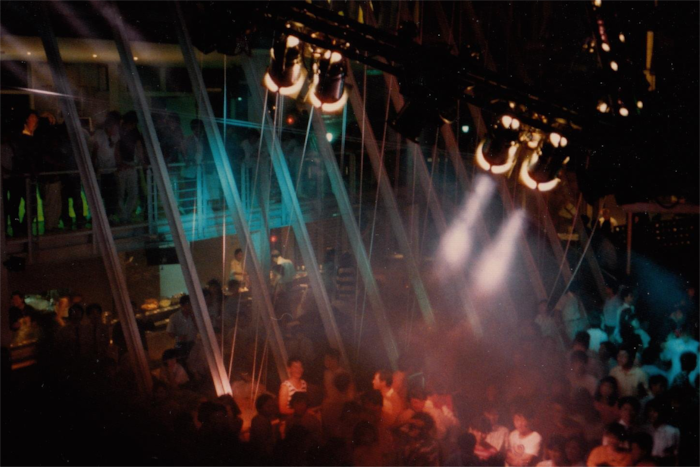
The 2018 Winter Olympics in South Korea were a testament to the will of diplomacy, soft power and cross-country partnership, resulting in historic meetings between leaders of a divided peoples and even the consideration of Seoul and Pyongyang co-hosting a future Summer Olympics. But the Pyeongchang Games weren’t the first time that South Korea bore witness to a unique cross-cultural exchange in the name of sport. While the 1988 Seoul Olympics made history for the country by day, by night revelry took place in the KunstDisco Seoul, a club and arts space put together by the Federal Republic of Germany which arguably introduced Western club culture to the country, and emboldened Germany’s own dance scene for years to come.
South Korea is known today for its flashy modernity and even flashier pop scene, but it was a very different country in 1988. Although it’s the democratic half of a split peninsula, it wasn’t so long before that the country bore more resemblance to the North. Military strongmen had long been in control of the nation, and the country’s first free elections had only taken place one year prior to the Olympics. The Seoul that welcomed visitors may have looked fresh out of the box, but it was a progression that resulted from a hard-line push on old neighbourhoods and the poor, the sort of crackdown that had extended for years on arts and culture with heavy censorship. Korea then was a nation proud to put on a show to the world, but perhaps one too weary to take care of the afterparty.
Enter the efforts of another country with divided borders, West Germany. In 1986, organisers of the Olympics approached the Goethe-Institut, Germany’s premier cultural association, looking for a project specially designed for young people. Answering the call was Jürgen Drews, head of the Music Department at the Goethe headquarters in Munich. He proposed the KunstDisco, or “art disco” in English, an exchange that would export liberal German youth culture through a mixture of art and music. The then-burgeoning German club scene would be represented by nightly DJ sets, whilst other genres from West Germany’s alternative scene would be introduced through evening concerts. A unique hybrid of gig and rave, the Kunstdisco Seoul would take place in one custom-built venue, with a program lasting the entire duration of the Olympics.
To help him with the lineup, Drews called upon Ernst and Hans P. Ströer, two brothers who’d made waves on the alternative scene with the Nomaden LP, a freewheeling collaboration that set Ernst’s jazz percussion and Hans’s new wave keyboards against the offbeat proclamations of American poet Howard Fine. Toeing the line between hyper jazz-funk and desolate mood music, the album’s general flexibility was matched with a live show that had its fair share of theatrical flair.
We were offering a totally new form of entertainment.
“Our show had rap, dance routines, even costumes,” Hans Ströer says in a joint email conversation with his brother. “That’s how we caught the eye of Jürgen, at our Nomaden stage show in Munich.”
The show occurred shortly after Nomaden’s release in 1985, a watershed year for German music that saw influential dance releases from Moskwa TV, the outfit who set up the pioneering Technoclub residency at Frankfurt’s Dorian Gray, along with the first recordings from future Berlin dancefloor hero Westbam, real name Maximilian Lenz.
Along with his brother Fabian, better known as DJ Dick, Lenz was recruited by the Ströers to be resident DJ at the KunstDisco Seoul after he was spotted by Jürgen and the brothers at a Munich club night. The Berlin-based duo weren’t to rely on the German and imported techno that made up their usual sets, though, instead choosing tunes from a selection of over 30 albums commissioned by the Ströers just for the event.
“The idea was to produce 24 hours of music to fit all the different moods of the KunstDisco,” Ernst Ströer explains, “and create a pool of private pressings that would be big enough to avoid constant replay. So, 36 full albums were made in total; the music could fill more than three days without repetition.”
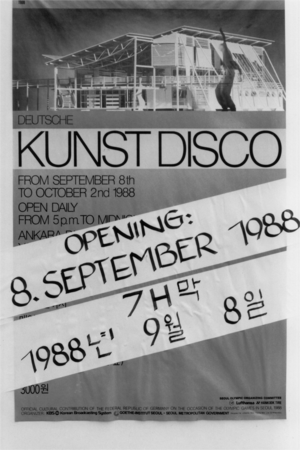
Another impressive technical feat of the event lay in the Ströers’ coordination of live performances over all 26 nights of the KunstDisco. Opening nine days before the start of the Olympics, no one night was the same, with new bands performing each evening. In the spirit of the club atmosphere, the lineups were mainly electronic; the Ströers, for example, tried their hand at club styles with the slinky electro of “Night Falls,” reuniting with Howard Fine for the track, dance routine included. (Fine was in charge of choreography for the KunstDisco, leading the dancers who entertained the crowds on a nightly basis.) There were also acts like the Berlin-based Thomas Fehlmann, a future member of the Orb performing under his first techno guise as Ready Made, and the electronic soul of the collaboration project Every 2nd, as led by avant-pop visionary Pyrolator, AKA Kurt Dahlke.
This material can be heard on Teutonic Beats Volume 1, a 1989 compilation of dance tracks contributed to the KunstDisco music pool, as compiled by Fehlmann and released on a label he was inspired to set up following the event, also known as Teutonic Beats. Early techno albums such as Fischerman’s Friend’s self-titled debut spun out from this material on the label, along with club hits like “Love Park” from Marathon, a duo which included Berlin’s Moritz von Oswald, the future dub techno pioneer behind Basic Channel.

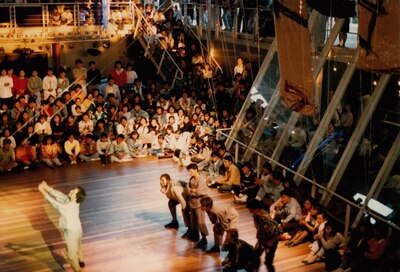

Teutonic Beats was mixed by Lenz, who in ’88 released his first LP of original music, Westbam in Seoul, as compiled from the same source of the KunstDisco. Aptly, the Berlin-developed sound which would be enjoyed by newly liberated German youth after the fall of the Wall was the same music enjoyed thousands of miles away a while before, by Korean youth celebrating their own newly-found freedom.
The Ströer brothers also gave themselves the task of creating live shows in the same vein of their Nomaden concert, designing a truly immersive experience. Anyone visiting the Kunstdisco would be offered a free make-over by professional make-up artists, for example, while both staff and performers were to be dressed by Michael Ody, a Munich fashion designer renowned for making his colourful, dandy-ish works from the likes of parachutes and bandages. They also commissioned abstract video art, intended to loop continuously around the dancefloor. But the brothers weren’t simply expected to be idea men, Hans remembers.
“It was a snowball principle,” he explains. “We choose the architects, the technical teams, even the catering, and all together we went to Seoul for the first time in ’87. We had just one week to meet possible local partners, building companies, engineers, embassy staff, creative partners, assistant partners of all kinds. All this without speaking any Korean!”
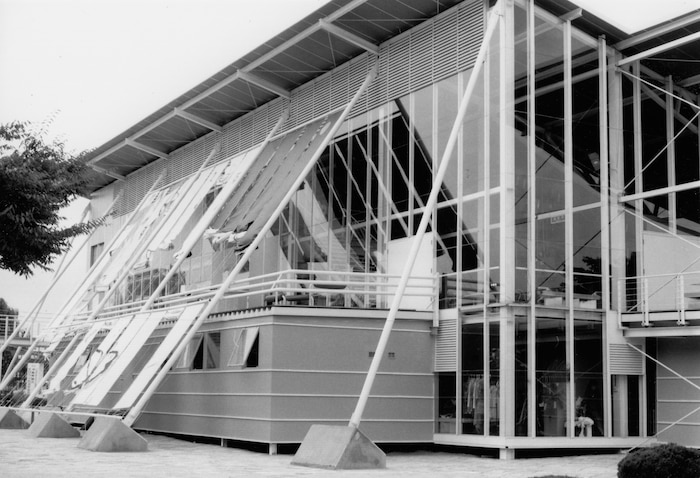
The location chosen by the Korean organisers for the KunstDisco was Yeouido, an island in Seoul on the opposite side of the city to the Olympic Stadium, and which is more commonly referred to today as the Korean Manhattan. It was here where the modernist structure of the KunstDisco was erected, a neutral colored building with slanted roofs that was more of an ode to the diagonal than anything that screamed “discotheque.” For Ernst, it was a place marked by having the “airy and cool atmosphere of a modern museum.” In keeping with its innocuous nature, the building was also fully transparent, owing to prevailing conservative attitudes.
“The fact that there was no club scene in Korea at the time led to the question of how to design the KunstDisco in a way that would be acceptable for Korean parents so they would give permission for their children to go, which was still necessary despite them being young adults,” Ernst says about the structure. “The answer to this problem was a fully transparent glassy building where everybody could see from the outside what was happening on the inside, with a public boardwalk besides the building and an afternoon opening time so people could come in and check the place at daylight.”
Despite such concerns about public decency, there were next to no guidelines from the Korean side, however novel the clubbing experience would have been for patrons. But as the Ströers discovered upon their first visit to Seoul, the word nightclub had a very different connotation in South Korea – not surprising considering the crackdown on go-go bars that was prevalent throughout the ’70s.
“We were trying to find local discos to check out how they were designed and what kind of music they played,” Hans remembers, “but in fact, at that time in Korea, the only kind of discos seemed to be clubs in hotels, not accessible for the local youngsters, serving mainly as contact spaces for business men and escort girls. We had some slightly embarrassing situations when we refused their offers and told them that we were looking for real discos with real people.”

“It’s important to remember that we were offering a totally new form of entertainment,” Hans continues. “Dancing, freaking out and enjoying cultural performances all in the space of one location. And we did not know if and how the local audience would react to that offer.”
The interplay between dance sets and live gigs didn’t come without its struggles, though, as Ernst confesses: “We wanted to create fluent transitions between the club atmosphere and the live appearances. The musicians came on the dancefloor with their instruments while everyone was still dancing (and looking very confused as to what was going on). Then, on cue, the DJs and the live sound engineer had to communicate for a perfect musical transition. Sometimes, people kept dancing while the musicians played in the midst of them just like we hoped it would work.”
“But sometimes,” Ernst continues, “people stopped dancing and formed a circle around the musicians and watched their performance. 20 minutes later, when the show was over, it was very hard for the DJs to get the people on their feet again, especially if the live act was, in the words of the DJs, ‘too much art and not enough disco.’”
Enough disco or not, the unique experience offered by the KunstDisco was why the majority of its visitors weren’t local sports fans or tourists, but local Seoul youngsters simply looking to let their hair down. The general optimism brought by the Olympics would have likely encouraged visitors to drop by, doing so even when the Olympics ended and the KunstDisco remained a permanent clubbing fixture in Yeouido until 1992, when it was dismantled and rebuilt in another park as an events space. The success of the KunstDisco demonstrated the country was ready to move on from the tensions of its previous administrations; ultimately, it was a safe place where a shared experience could be enjoyed by Korean youth. That said, out of all the German performances, techno raves and art happenings, it was actually a Korean act who left the biggest impression at the KunstDisco.
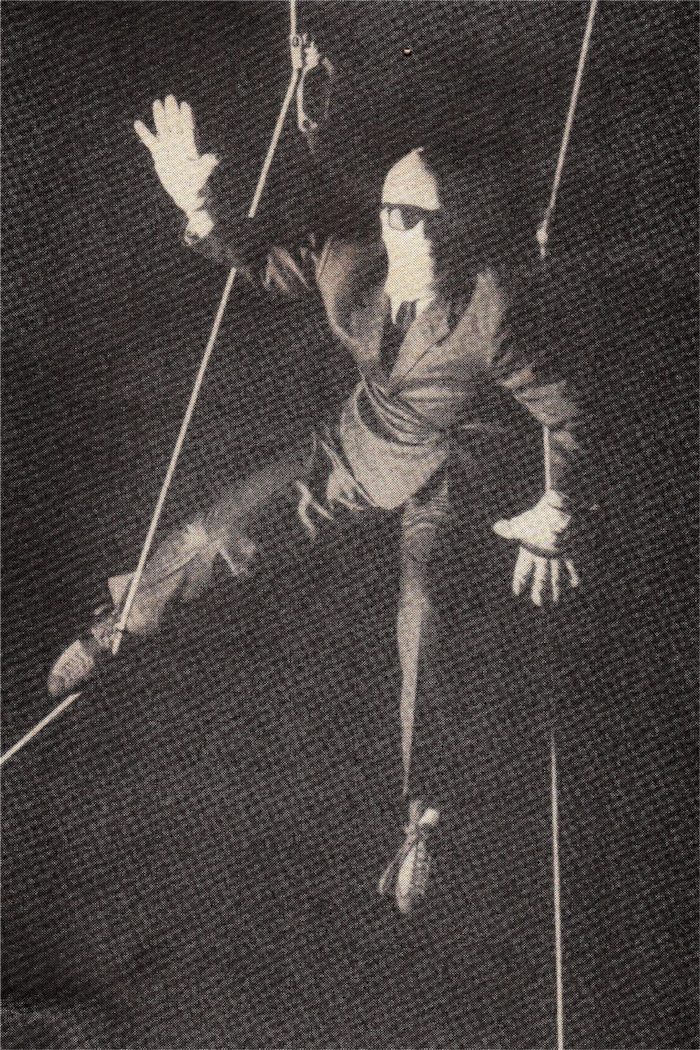

“There was a famous Korean singer we didn’t know before, who came in one evening and asked if she could perform a song,” Ernst recalls. “She was given a mic and went in front of the dancefloor. The music stopped, and everyone stopped dancing. She began to sing something like a Korean folk song, a very slow, melancholic melody. People were so quiet you could hear a pin drop between her lines. Slowly, one after the other, everyone listening took the hands of their neighbours. Slowly, the song picked up steam. People began to move, they started to walk around. As they were holding each others’ hands, it looked like a serpent slowly creeping up the stairs on to the second floor while the head of the snake was coming down again on the other side. Imagine 1,000 people doing this, and while she kept singing, people sped up their movement. Finally, they started to run as fast as they could, up and down the stairs. It was awesome and scary at the same time; the whole building trembled. Then, some of the people laughed out loud, while some fell down and the ‘serpent’ broke into pieces. People were lying on the ground, exhausted, laughing. It was an unforgettable moment.”
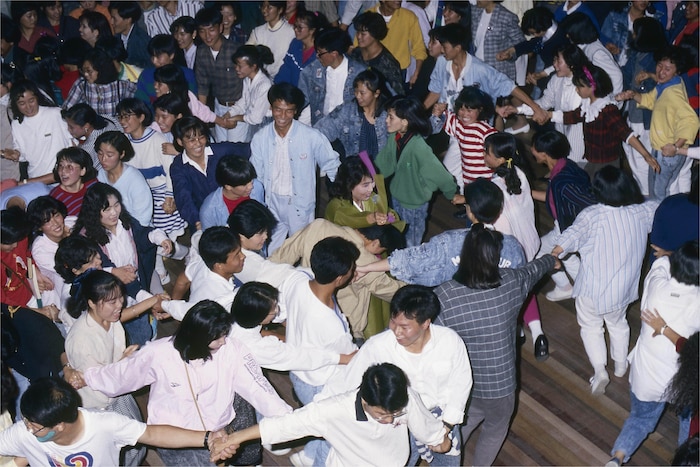
Though the KunstDisco eventually became a sports training centre, undergoing dismantlement almost a decade back, it’s memories like these that keep its legacy alive today in both the buzzing nightlife and beloved pop music of Korea. You can even feel its influence in the yearly indoor Mayday rave, as set-up by the Lenz brothers in Germany at the start of the 1990s. The dedicated work by the Ströers and company also shows what can come out of cross-cultural partnerships like the Olympics; after all, isn’t dancing one hell of a dialogue?

